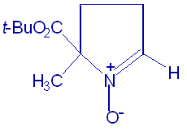Oxidative Stress
| APPLIED BIOANALYTICAL LABS providing tools for oxidative stress research |

Product Name: BMPO Spin Trap
5-tert-butoxycarbonyl 5-methyl-1-pyrroline N-oxide
C10H17NO3, MW = 199.25
Product Specification:
Purity: >99% (NMR), EPR grade
Appearance: Off-white, crystalline
Solubility: Soluble in water
Shipping: Express mail or regular mail on blue-ice
Storage: Room temp (short term), <-20oC, desiccated (long term)
Catalog numbers Size Unit Price
BMPO-50mg 50 mg $290
Description And References:
Electron Paramagnetic Resonance (EPR) spectroscopy is the only known method to "see" free radicals. However, direct detection of
some free radicals (e.g., superoxide and hydroxyl radical) is very difficult or impossible in solution at room temperature. Spin trapping
is a technique developed at late 1960s where a nitrone or nitroso compound reacts with a target free radical to form a stable and
distinguishable free radical to be detected by EPR spectroscopy. Spin trapping is the only known method that can detect free radicals
such as superoxide and hydroxyl radical specifically in biological systems.
BMPO is a newly discovered nitrone spin trap from Prof. Kalyanaraman's lab at Wisconsin Medical College. It is most suitable for the
specific in-vivo or in-vitro detection of short-lived superoxide, hydroxyl radical and thiyl radical, by forming distinguishable adducts
measurable with EPR spectroscopy. Other nitrone spin traps such as DMPO does not distinguish superoxide and hydroxyl radical
easily because of spontaneous decay of DMPO-superoxide adduct (t1/2 = 45 seconds) into the DMPO-hydroxyl adduct. Similar to the
recently developed spin traps DEPMPO and EMPO, BMPO-superoxide adduct does not decay into a hydroxyl adduct and has a much
longer half-life. The half-life of superoxide adduct is longest for BMPO (t1/2 = 23 minutes). Additionally, DEPMPO and EMPO are liquid
spin traps that are often contaminated with nitroxide impurities and have limited shelf life. BMPO, being a solid cyclic nitrone, is highly
purified by crystallization, and can be handled and stored for an extended peroid of time without fear of decomposition. Finally BMPO-
derived adducts exhibit a much higher signal-to-noise ratio in their EPR spectra, and it may be suitable for detection of sulfite, hydroxyl
and methyl radicals in cell suspension.
1. Zhao H., Joseph J., Zhang H., Karoui H. & Kalyanaraman B., Free Radi. Biol. Medi. 31, 599-606 (2001)
2. Khan N., Wilmot C. M., Rosen G. M., Dmidenko E., Sun J., Joseph J., O’Hara J., Kalyanaraman B. & Swartz H. M., Free Radi. Biol.
Medi. 34, 1473-1481 (2003)